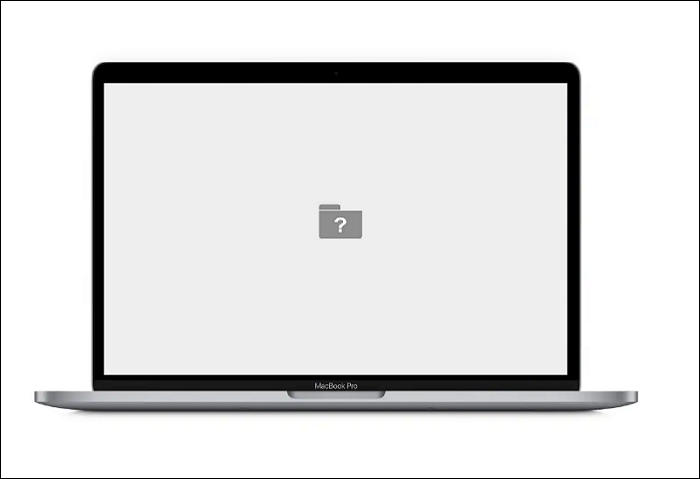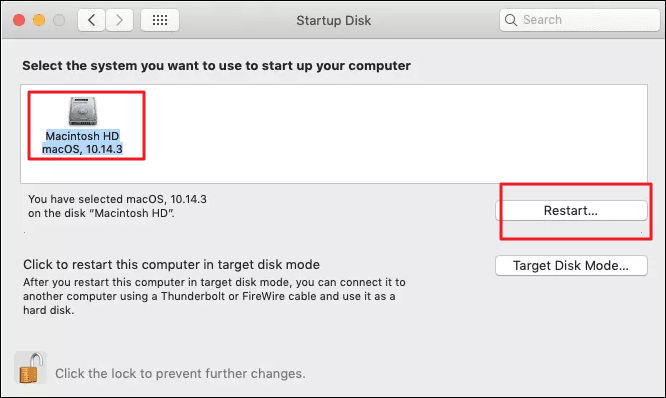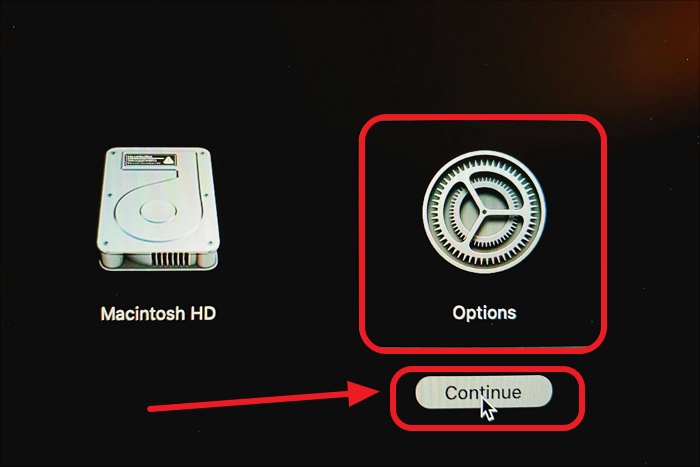How to Fix Mac Flashes Folder with Question Mark on Startup? [macOS 13/12/11 Applicable]
If you see your Mac flashes folder with question mark, it indicates that the Mac cannot locate the startup disk and boot the macOS. Here is the quick navigation of 6 fixes to this error.
| Workable Solutions | Step-by-step Troubleshooting |
|---|---|
| Fix 1. Check System Preferences | You can manually choose the proper startup disk from System Preference if your Mac can't boot...Full steps |
| Fix 2. Reset NVRAM | Resetting the NVRAM/PRAM is essential as a remedy if the Mac startup disk has gotten corrupted...Full steps |
| Fix 3. Boot Mac in Recovery Mode | You cannot boot your Mac in a regular way. Instead, you can enter macOS in its Recovery Mode...Full steps |
| Fix 4. Repair with Disk Utility | Disk Utility can scan the connected disk and repair problems when it detects them...Full steps |
| Fix 5. Reformat Mac Startup Disk | If Disk Utility can't fix the issue with the startup disk, you might need to reformat it...Full steps |
| Fix 6. Reinstall macOS | If the Mac startup disk still cannot respond after repair, you can try to reinstall macOS to solve it...Full steps |
A Mac folder with question mark flashing on startup can be one of the worst things ever. This signal means that your Mac cannot recognize its starting disk or has no startup disk, which prevents it from booting. This may happen if your hard drive fails or you begin your Mac from an external disk and then unplug it.

Possible Causes for Mac Folder with Question Mark Flashing
There are numerous potential causes of the Mac question mark folder issue. The error may occur if the Mac cannot identify its boot directory. Here are a few explanations for why you might encounter this issue:
- The hard drive/disk has failed
- The macOS has corrupted
- The file system has been damaged
These elements can all be divided into hardware- and software-related categories. The associated fix can range from simple to complex, depending on what is responsible for the Mac question mark folder issue.
Recover Data from Unbootable Mac with Question Folder
When a MacBook has a question mark folder on its screen or when there are other macOS won't boot problems, there is a chance that your data could be lost or corrupted. Your files and data might be lost if you force the device to reboot.
The first consideration is data recovery, which can prevent permanent data loss from Mac repairment when it cannot boot normally. So, you can use data recovery software like Deep Data Recovery Bootable Media to create a bootable disk and restore data after rebooting.
Deep Data Recovery for Mac
- Recover formatted hard drive on Mac, enables you to recover data from Mac hard drive if your Mac hard drive has failed.
- Make a bootable USB for Mac; recover data from the Mac won't boot or restart after reinstallation.
- Recovers data from failed Mac Recovery Mode, corrupted macOS, and unmountable startup disk and file system.
Following the steps below will help you create the bootable disk utilizing Qiling Data Recovery for Mac to restore the data.
How to Create a USB Bootable Media
Step 1. Install and run Deep Data Recovery for Mac on another Mac computer, and select "File > Create Bootable USB". Then, choose a USB drive to create the bootable disc.
- Warning
- The creator will prompt to erase the drive to reallocate the space; then it can write the bootable files to this drive. Please back up all USB files before processing "Eraser".
Step 2. The program starts to create a 2GB space and save the boot files. The rest space on the USB can be still used for storage.
Step 3. Once it completes, please follow the guide to boot the corrupted Mac from the bootable disc and start the recovery. We suggest you restore the data to an external hard drive.
How to Recover Data from Mac Hard Disk
Step 1. Select the disk location (it can be an internal HDD/SSD or a removable storage device) where you lost data and files. Click the "Search for lost files" button.
Step 2. Deep Data Recovery for Mac will immediately scan your selected disk volume and display the scanning results on the left pane.
Step 3. In the scan results, select the file(s) and click the "Recover" button to restore data from Mac.
6 Fixes to Apple Folder with Question Mark Flashes on Startup
The macOS might fail to find the startup disk if there are issues in starting Mac appearing in a flashing folder with a question mark. You can't avoid the Mac question mark folder icon even after a restart. In this part, we will go through every aspect and offer six ways to fix the mac startup problems.
Fix 1. Check System Preferences to Reselet Mac Startup Disk
You can manually choose the proper startup disk from System Preference if your MacBook can't turn on and displays a folder with a flashing question mark.
Step 1. Select Startup Disk under System Preferences in the Apple menu.
Step 2. Choose the Startup Disk icon, which is typically called Macintosh HD.

Step 3. Click Restart to check if the flashing question mark folder is no longer visible on your Mac.
Fix 2. Reset NVRAM
Resetting the NVRAM/PRAM is essential as a remedy if the Mac startup disk has gotten corrupted. You can try these steps:
Step 1. Shut down the MacBook first and wait for more than 20 seconds.
Step 2. Press the power button and simultaneously hold the option keys: Command + option + P + R.

Step 3. When you see the Apple Logo again, release the keys.
Step 4. After the Mac finishes starting up, you have done the reset of NVRAM.
Fix 3. Reboot Mac in Recovery Mode
Since your startup disk has failed, you cannot boot your Mac in a regular way. Instead, you can enter macOS in its Recovery Mode.
Step 1. You can boot Mac Recovery mode using various keys depending on whether your Mac is based on Apple silicon or an Intel CPU.
- Apple silicon: After turning on your Mac, press and hold the power button until the starting options menu appears. Select Options - Continue.
- Intel processor: After turning on your Mac, press and hold the Command + R keys until an Apple logo or other image appears.
Step 2. Enter a password to continue. Next, you can boot in macOS Recovery mode.
If you successfully boot the Mac into Recovery Mode, choose Disk Utility on the window to repair the Startup disk. Continue reading to learn about the detailed instruction in Fix 4.
Fix 4. Repair Your Mac Hard Drive with Disk Utility
Disk Utility can scan the connected disk and repair problems when it detects them. Now try to follow the below steps to repair the Mac startup disk.
Step 1. Turn off the Mac and disconnect all peripherals.
Step 2. Choose Disk Utility in Mac Recovery Mode's macOS Utilities window.

Step 3. Then you can run the Disk Utility to scan and repair the Mac startup disk.
Fix 5. Reformat Mac Startup Disk
If Disk Utility can't fix the issue with the startup disk, you might need to reformat it. This procedure will wipe out all data on the startup disk, so back up the data if permitted.
To start the reformation, boot your Mac in Recovery Mode and enter Disk Utility as the Fix 3 and Fix 4 conducted.
Step 1. Select Macintosh HD in Disk Utility and select Erase.

Step 2. You'll see an option to change the disk name and format in the pop-up window.
Step 3. Pressing Erase Volume Group, which removes all data from your hard drive.
When the process is finished, shut down the Disk Utility. You should see a new SSD on our desktop.
Fix 6. Reinstall macOS from USB Drives
If the Mac startup disk still cannot respond after repairment, then you would try to reinstall macOS to solve the problem of the Mac folder with a question mark flashing on startup.
Since your Mac cannot boot regularly, you have to install the macOS from USB. So, you can download the installation files from the other device and launch the reinstallation from the USB.
Step 1. Format an external USB drive that you tend to store the macOS installer first.
Step 2. Download the macOS installer from another Mac or Apple's website.
Step 3. Create a bootable USB disk using Terminal by typing these command lines:

Finally, boot your Mac from the USB drive. After reinstalling the macOS, you can check if the mac flashes a folder with a question mark problem is fixed.
To Sum Up
Following the above fixes, you can fix the Mac startup issue after applying the modifications without losing your data. You need to keep it in mind to back up your data or restore it as soon as possible. Deep Data Recovery for Mac could be of great assistance to you.
Mac Flashes Folder with Question Mark FAQs
Here are 4 questions about the Mac flashes folder with a question mark. Check here for the answers.
1. What is a folder with a question mark on Mac?
When you turn on a Mac, the screen displays a flashing question mark in the middle rather than the Apple logo. This issue indicates the startup disk is damaged and occurs across Apple Mac computer products, including MacBook, MacBook Pro, and MacBook Air.
2. Why do I see a flashing folder with a question mark after replacing the hard drive?
Because the Mac no startup disk error occurs. As a result, your Mac cannot load the macOS from the hard drive into memory to launch the operating system. The mac question mark folder signifies:
- Hardware-related problems with your startup hard disk or logic board
- There are problems with the software because the startup disk doesn't have a copy of macOS that works
3. How do I fix it if my Mac starts up to a question mark?
You can try these fixes and follow the detailed guideline above.
- Repair startup disk in macOS Recovery
- Make the startup disk appear in the disk utility
- Reset NVRAM on your Mac
- Restall the macOS
Related Articles
- [2023 Tips] Update Not Found - The Requested Version of macOS Is Not Available
- How to Sync Two External Hard Drives in Windows 10 [Two Nice Tips]
- [2023 Fixes] How to Fix Your Computer Was Unable to Start
- 3 Proven Ways to Download & Install macOS 12 Monterey for Free [2023 Tips]
